[Travel Notes] On April Day in the World, my trip to Fujian (Part 1: Xiamen, Gulangyu, Tulou)
Xiamen is neither an unfamiliar city nor a familiar place to me. I am sure I have been there, but my memory is getting blurred and I can't even remember where I spent a few days or what I saw. It was a long time ago, about 85 years in the last century. It was a business trip with the boss of the company, and I didn't dare to think too much about playing. In addition, I had so little experience at that time that I really didn't know how to find time to visit Xiamen more. So I only remember seeing several places following the arrangements of the big shots, and I only remember that Xiamen is very beautiful. Therefore,"I must go and have a good look at Xiamen when I have time" has always been one of my wishes.
Departure: Beijing-Xiamen
On April 15, 2021, a warm, clear and comfortable day started my trip to Fujian.
The flight from Beijing to Xiamen leaves at 11:10. I haven't traveled by plane for a long time. Since the completion of Daxing Airport, I have always wanted to see the only airport work of designer Zaha when I had the opportunity, so I specially bought a flight from Daxing Airport this time. In order to have a good look at the airport, I set off from home before 9 o'clock and took the subway and Airport Express to the airport at about 11:00. After checking in my luggage, I visited the airport inside and outside. This airport is so grand! I won't describe it in professional terms, but I am really shocked by its coolness.



After looking inside and outside for almost an hour, it was time to go to security and board the plane. The plane basically took off on time. Today's flight was very bumpy due to the airflow, but fortunately it arrived in Xiamen safely and on time. Xiamen's Gaoqi Airport Terminal is very interesting, thin and long, like a train. As soon as I came out of Xiamen Gaoqi Airport, I saw palm trees on both sides of the street. The ordinary sight of the south aroused a little excitement in my heart. In fact, this kind of tree is probably as common in Xiamen as poplar, willow, and smelly toon trees in Beijing.



After walking not too far from the airport, I found the No. 37 bus that I had checked in advance. I took a ride directly to the entrance of the Motel Hotel I booked for one yuan, and it went smoothly. I have stayed at Motel Hotel in Nanjing before and it was affordable, so I chose it again. After checking in, in addition to calling home to inform you that you are safe, I went nearby to get familiar with the terrain and environment. I went to the supermarket to buy some fruits, snacks, etc., then went to the Hakka snack bar in the food city and ordered the Hakka taro buns and pork soup set meal. It was not bad.

On the 16th, we participated in a group to visit Tulou in Nanjing according to a one-day tour of Tulou booked in advance online. However, after listening to the tour guide's trick, I changed to going to Yongding Tulou Group (there is Tulou Wang Chengqi Building here) instead of not going to Tianluokeng Tulou Group (four dishes and one soup). How many times have I seen an introduction to Fujian Tulou on TV, but when I really go to the Tulou, enter the Tulou, and see the lives of some residents who still live in the Tulou, I can still find a sense of transcendence. I am also amazed at the wisdom of their Hakka people in building houses. It's just that the commercial atmosphere in the Tulou is too strong now. Except for a few residents upstairs, the first floor has become tourist goods shops. The whooping cries make people feel less good.







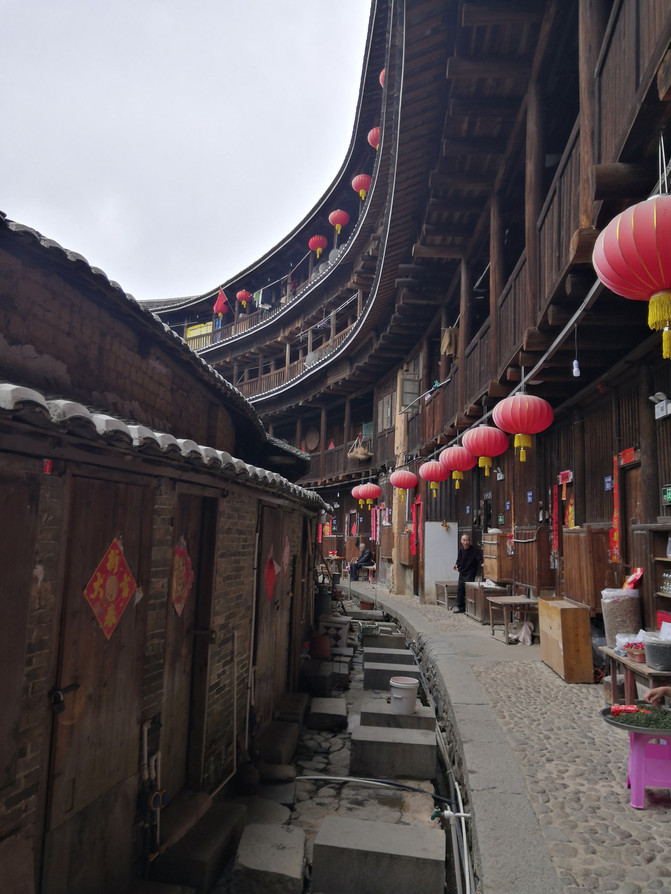

At noon, the tour group arranged to eat local Hakka rice in Yunshuiyao Ancient Town. To be honest, the meal should be considered good as a group meal, but since the epidemic broke out, it seemed like my heart had fallen ill, and it was difficult to bear eating with strangers. I took the lead in distributing public chopsticks to everyone and issued a request to use public chopsticks to a table. The group members were quite conscious, but they still swallowed a few mouthfuls of rice and quickly left. Coincidentally, the tour guide said that those who had eaten early could visit the Yunshuiyao Scenic Area by themselves, so I followed the route designated by the tour guide and followed the thousand-year-old ancient road on the bank of the green river. I counted eight century-old banyan trees in a row and enjoyed the picturesque scenery of Yunshuiyao. In fact, this place was not originally called Yunshuiyao. Because the movie "Yunshuiyao" was filmed here, the tourism department here took advantage of the opportunity to rename this scenic spot Yunshuiyao Ancient Town. In fact, the resident ID card address here is still Pushan Village, Nanjing County, Zhangzhou City. This name change should be considered a very successful one. I have seen the movie "Yunshui Rumble" before, but I don't remember the scene taken here in the movie. However, I like the name "Yunshui Rumble" very much anyway, which is in line with the romantic warmth of this scenic spot.


When returning to Xiamen at night, the bus took a ferry across the sea and returned to Xiamen Island. In about 40 minutes at sea, I covered the night view of Ludao.




The one-day trip to Tulou is quite rich in content. It's just that I haven't traveled with a group for a long time, and I feel very uncomfortable just for this day. Fortunately, I won't be able to endure another day.
17th. Today, I finally started to stroll by myself. I rode my bicycle to a nearby Sili Shacha Noodle Restaurant early in the morning. I saw that this store had a good reputation online. I ordered a bowl of the famous seafood Shacha noodles. The taste of Shacha sauce was not very comfortable, but the lot of sea carp meat and squid rings tempted me, so I still ate quite comfortably.
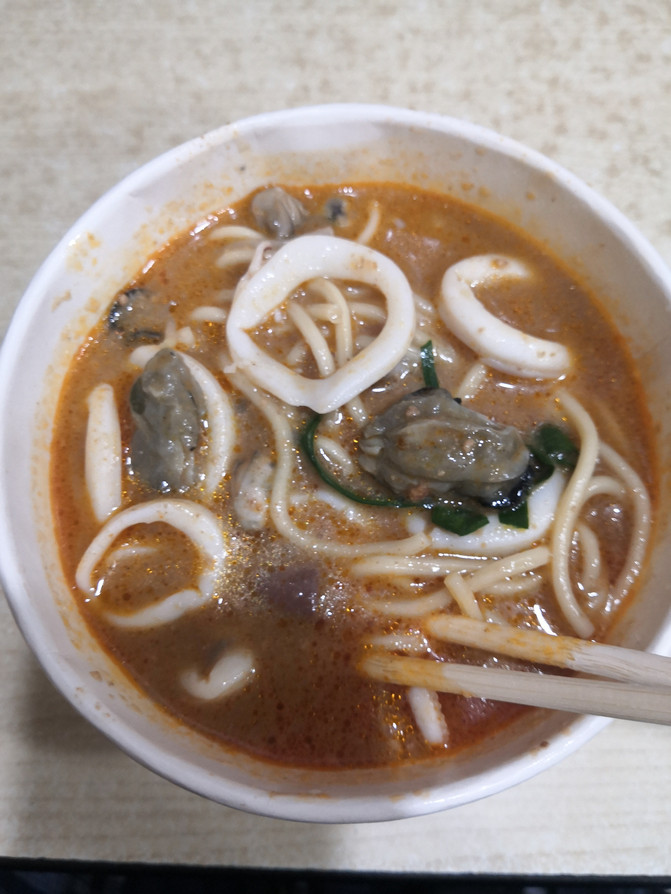
Then I took the bus to Nanputuo Temple. Nanputuo Temple is next to Xiamen University. The beautiful memory of this university more than 30 years ago has become blurred and unreal, so I really want to go in and have a look, but due to the epidemic, the campus is no longer allowed to visit.

After entering Nanputuo Temple, it has always been difficult to tell how I feel about the temple. I have never believed in a religion. However, when I see many people earnestly praying for God and Buddha, I will sincerely stop and look and silently pray for Buddha's blessings. Intuitively felt that there were more believers here and more devout than in the north.
Nanputuo Temple is located on the coast of the southeast coast, backed by green mountains, with scattered heights and heights. The architectural style is very different from that of the northern temples. It has thin lines of hollow and fancy roofs and ridges, and exquisite colored ceramic murals reveal a strong South Asian and Southern Fujian styles:





Coming out of Nanputuo Temple, I originally wanted to ride a bicycle to the Huandao Road to the seaside. As a result, I first arrived in front of the Twin Towers World Trade Center. In the past two days since I arrived in Xiamen, I have seen these tall twin towers many times from the sea, land, cars, boats, day and night. So I put down my bicycle and entered the Twin Towers. One. When I entered the elevator and saw that I could reach the 38th floor, I arrived here first. After observing, I found that you can eat and drink on this floor, and there seemed to be a buffet. However, when I asked about it, I realized that the meal was over, so I went to the nearby tea room and asked for a pot of fruit tea "Summer Peach" that is very suitable for a person like me to "pour and drink" myself. Sitting alone in a cubicle, overlooking the blue sea and blue sky, overlooking the winding roundabout road below and the pedestrians and cars as small as ants on the road. In the distance, you can see Gulangyu Island wrapped in green trees. It's so comfortable to be quiet and taste the nectar.




Then I took the elevator to the 54th floor and took a look. Looking out from this floor, the view was wider. The people and cars on the roundabout road became smaller and almost impossible to see clearly. This is a lounge for business negotiations. Ha, a staff member came over and politely asked if he needed anything, and then told me that if it was not a guest, he could not visit it here, so I took the elevator downstairs. Then he drove another bicycle and continued on to Huandao Road. The roundabout road is built on the sea with an open viewing platform. I stopped my bicycle and walked for a while, thinking in a daze under the sea breeze.
Then we rode a bicycle for a while, stopping and stopping, to enjoy the sea view and the people watching the sea view. Xiamen is indeed a charming and romantic place. As the sun sets, walking along the beach, a group of people gathered around a couple of newlyweds to take wedding photos at a distance of tens of meters and less than 100 meters. It was beautiful.

Then we rode a bicycle for a while, stopping and stopping, to enjoy the sea view and the people watching the sea view. Xiamen is indeed a charming and romantic place. As the sun sets, walking along the beach, a group of people gathered around a couple of newlyweds to take wedding photos at a distance of tens of meters and less than 100 meters. It was beautiful.

The unique coconut or palm trees in the south always attract me to stop and take photos:


Unconsciously, it was evening, and now I ride my bike to the famous Zengcuo 'an. When I arrived near Zengcuo 'an, there were more people, and most of them were young people. As night fell, there were many stalls selling flowers and bouquets on the roadside. There were many young couples holding flowers in their hands, and some young men walking alone also holding a handful of flowers in their hands. Their faces showed happy expectations. Needless to say, they were going to meet their girlfriends. These small details added a romantic atmosphere to Zeng Cuo 'an on the beach. It's hard to be romantic when entering small streets. The alleys are narrow, densely packed with shops, crowded with people, and you can only follow everyone in one direction. The various snacks in the border are quite tempting. The most common snack is oyster fried. Please have one.

It was around 8 o'clock and I was ready to go back. After leaving the bustling snack street of Zengcuo 'an, we entered the inn area deep in the streets and alleys. The scene here is very different from the scene just now. It is very quiet, and the inns are all decorated in a very literary and artistic manner.
Crossing this area, I almost reached the main road, and I clicked a drip back to my place.
I got up early on the morning of the 18th.
A few years ago, when Xiamen Metro Line 1 had just opened to traffic, I saw subway trains flying across the sea on TV. It felt so cool, so I planned to experience the sea subway from the beginning when I planned to come to Xiamen. After checking, we found that Line 1 to Jimei can cross the sea. Jimei is precisely a very beautiful place in Xiamen's memory a long time ago. I have always kept a photo taken in Jimei in my photo album: wearing a white short-sleeved shirt that looks a little like a sailor's uniform on the upper body, and a short skirt on the lower body. It's very schoolish look.
The section of Metro Line 1 from Gaoqi to Jimei Xuecun runs on the Cross-Sea Bridge. I was a little excited when I reached this section, so I quickly took out my mobile phone to take a video. However, this section was too short, and the water in this section of the sea was very shallow. In addition, various facilities on both sides of the train blocked the line of sight, so this driving experience was not as cool as I once expected. So after getting off the bus, he took a detour back to the cross-sea bridge and watched the train driving on the cross-sea bridge from the beach. However, it was still not as cool as I had seen on TV before.


When you arrive at Jimei School Village, you ride along the path on the side of the Dragon Boat Pond. The Dragon Boat Pond is a place for students from Jimei University to race dragon boats. On the other side of the path is the Jimei University, Jimei Middle School and other buildings designed and funded by Mr. Chen Jiageng. This building complex is called Nanxun Building Group. These buildings, which are nearly a century old, still look exquisite and magnificent today.
A brief introduction from the Internet: At the age of 17, he went to Singapore to do business with his father. He started a business hard and achieved great success. He became a famous "rubber king" in Southeast Asia. He holds the concept that "education is the foundation of a country, and the development of education is the natural duty of the people." In 1913, he returned to his hometown of Jimei and established Jimei Primary School, Middle School, Normal School, Aquatic Products, Navigation, Business, Agriculture and Forestry Schools (collectively referred to as Jimei School) and Xiamen University. After the outbreak of the Anti-Japanese War, regardless of his personal safety and loss, he was publicly elected as chairman of the General Association for Overseas Chinese in Southeast Asia to raise relief for the motherland's refugees. He campaigned for the national disaster. Under his call, overseas Chinese in Southeast Asia contributed and contributed to the motherland's victory in the Anti-Japanese War. sacrifices. His high character and integrity have won high respect from compatriots at home and abroad.






Jimei Middle School, which has been in the past 100 years, is probably the most beautiful middle school in the country. The Navigation College and Overseas Chinese College in Jimei University are also very beautiful.


Later, I went to visit Jiageng Park by the sea. The Chen Jiageng Memorial Hall is in the park, and the Jiageng Tomb is also in the "Ao Yuan" in the park. However, Ao Yuan is currently closed and can only be seen from afar.




The embossed in front of the memorial hall records Mr. Jiageng's oath to run a school "would rather have the company close than the school closed." Such great sentiments and great deeds of patriotism, love, and benefiting future generations should be remembered and respected by generations.
During the visit, I kept thinking about the difference between Mr. Chen Jiageng's donations to run schools and today's schools run by celebrities. Perhaps the biggest difference should be that Mr. Jiageng is the one who provides help to the motherland and nation in need and has no selfish heart. However, nowadays, celebrities run schools mostly for self-interest and circle, and it is not even the icing on the cake.
After that, I went to see the former residence of Jiageng on the other side of the Dragon Boat Pond. According to reports, Kageng's former former residence was blown up by Japanese jets in 1938. This house was rebuilt on the basis of the original building with government funding in 1955.


Bike to the subway station at 2 o'clock in the afternoon. After one stop on Line 1, we arrived at Yuanbo Garden. This garden is essentially similar to the gardens and exhibitions in other places. Each province or prefecture corresponds to a small garden. The construction is rough and conventional. However, its biggest highlight and feature lies in the base of the garden. It was built on several small islands near Jimei, and there are bridges between the islands, giving you the experience of enjoying a park on the sea.




There is a long distance between the small islands, and there are few tour bus stops in the park. After buying a small train ticket, I can't find the station, which is very tiring (when I look at my mobile phone at night, the number of steps counting exceeds 30,000). I returned to the hotel at nearly 7 o'clock in the evening and had a meal of fried buns nearby. A few days ago, a ticket to Gulangyu had been booked for tonight. Although there was no time limit, I didn't dare to be too late. So I picked up my luggage and quickly took a taxi to the ferry. It only took the boat less than ten minutes to reach Sanqiutian Wharf on Gulangyu Island. At about 9:00, we finally found the booked Angel Garden Hotel.

This is the most common folk inn in Gulangyu. The room I stayed in is relatively small. Fortunately, I don't have any high requirements. It's enough to have a separate room and a separate bathroom. After a brief wash and rest, I walked outside the inn and took a look. It turned out that it was next to another cruise ship terminal-Piano Pier. This was a ferry terminal only for local residents to travel between Xiamen and Gulangyu Island. At this moment, there are fewer and fewer tourists on the dock. The large-screen TV has been playing the song of Gulangyu. It is very pleasant to sit down casually, enjoy the sea breeze and watch the night view.
I slept in on the morning of the 19th. Although I was woken up early by the chirping of birds outside and the sound of small horns from various tourist groups on the road, I still stayed in bed until almost 9:00. I was really tired yesterday and didn't care about doing the next day's strategy. So after getting up, first check the locations of various Gulangyu attractions online to find out who is closer to whom. Gulangyu is just a small island of less than 2 square kilometers. When it comes to visiting here, whether it is online or relatives and friends around me, they all feel that such a place will be over one day and stay for a day at most. However, this is not my first time to Gulangyu. My distant memory tells me that when I come to Gulangyu, I have to slow down, calm down, feel the air of Gulangyu, and slowly walk through the branches of Gulangyu. So I still booked a two-day stay (if I wasn't afraid that I wouldn't be able to get home before May Day, I would have stayed longer).
I didn't go out until after 10 o'clock. First, I went to a nearby shop and ate a bowl of fish ball noodles. Then head north first. Walking along the small streets of Gulangyu Island, I truly experienced the feeling of visiting the World Architecture Museum. After walking a few steps, the Harley Grandma Courtyard on the roadside attracted me to stop and take photos. Looking carefully at the sign, this small courtyard was once the seat of the Fujian Provincial Committee and the Military Commission of the Communist Party of China in 1930. It was the "headquarters" that commanded silent wars at that time. It is hard to imagine what happened in this beautiful small building and beautiful small courtyard.

There was an interesting thing when I first took the photo: I saw it was quiet in front of Grandma Harley's door, so I set up a tripod to take a selfie. It happened that two ladies passed by and I signaled that they were taking pictures. They stopped very friendly and said,"Are you just coming out alone? I'm quite good at playing."I was afraid that people would think she was a woman who" ran away from home ", so I quickly explained: Oh, alone, why can't my family come out together, and I asked," Where are you from?" I answered "Beijing", and then three people walked over from afar and shouted,"We are also from Beijing. Where do you live?" I answered "Haidian","Oh, we are also from Haidian", I said I lived in Wudaokou, and they said,"Hey, we're almost neighbors. We live in Zhanchun Garden, south of Wudaokou." God, the world is so small!
It's not far past the Organ Art Center. Tickets are charged here, so I bought a pass to five attractions in Gulangyu here for 90 yuan. The interior of the art center is made to look like a chapel, and the organ is also placed in accordance with the rules of the church. Two pipe organs, one big and one small, were transformed and connected together, and connected to an electronic keyboard controlled by an electronic chip. The performer records the performance of the electronic keyboard into the chip, and then the chip can automatically control the keyboard and automatically play the pipe organ works. According to the staff, the organ here was used in a church in Boston. Unfortunately, the church was caught in a fire and the organ was damaged. It was later auctioned off. It was bought by an overseas Chinese and donated to the country (it's still good to have money, and it can do big things). I have never seen such a big pipe organ before, let alone listen to it with my own ears. The sound from the huge pipe organ seems to resonate with people's heartstrings, as if it comes from the sky, shocking people's souls. No wonder the pipe organ has been used in churches.


Gulangyu Island is known as the Museum of Architecture of the World. Although we all know that this "Architecture of the World" is deeply engraved with the humiliating history of China being humiliated and bullied by Western powers, this has long become history after all. Now this is the land of the motherland. History cannot be forgotten, but it does not hinder our love for architectural art. Gulangyu Island, a green island, is inlaid with these various ruby-like villas, mansions and other foreign buildings, giving it a unique artistic charm that is exquisite, elegant and has experienced vicissitudes. The small island shows the huge capacity of embracing rivers and rivers.

Following Baidu navigation, I wanted to find the former site of the U.S. Consulate. I first saw a group of people taking photos around a red round-corner building. I suddenly realized that this was the most beautiful corner where Internet celebrities checked in (it also seemed to be the former site of the private Hongning Hospital). In fact, Gulangyu, an island lined with rows of foreign buildings, has similar corners everywhere. Perhaps the color of the building and the angle of the corners are more in line with people's aesthetics and golden standards. Perhaps the green trees next to it and the wooden stop signs at the corners make it more literary and artistic., but perhaps it was just because a romantic movie "Encounter Love at the Corner" was filmed here (I have never seen this movie either) that made it so popular. From morning to night, a group of little girls sometimes with their photo partners-boyfriends-line up here to take photos. This situation is a bit noisy, so I won't join in the fun. Go to a secluded small street nearby and make yourself happy to take a selfie.


Navigated to the former site of the U.S. Consulate. Many plants in the fence blocked the main building, making it impossible to see what the room looked like. Forget it, go and look elsewhere.
Seeing that the road sign pointed to Bi Cave, I walked in this direction.
After I saw the boathouse mentioned by someone on the Internet, it is now a hotel.

However, this small building is quite interesting. The door of the courtyard is sandwiched by high and low paths on both sides, forming the "most beautiful corner".

Along the way, I never found the Bi Cave, only saw Bishan Park. The area I passed by is probably called Neicuo Ao. It has few people, is very quiet, and has a good environment. Pass by the "Sanhe Gong Ji Cliff Stone Carvings", the former site of the HSBC Mansion. This mansion can be visited normally, but there are activities inside at this time. Some people are having a meeting and suspend the visit. From the height of Bi Mountain, you can overlook the many surrounding villa buildings with scattered heights. Coupled with the blue sea and green trees, there are pleasant pictures in all directions.



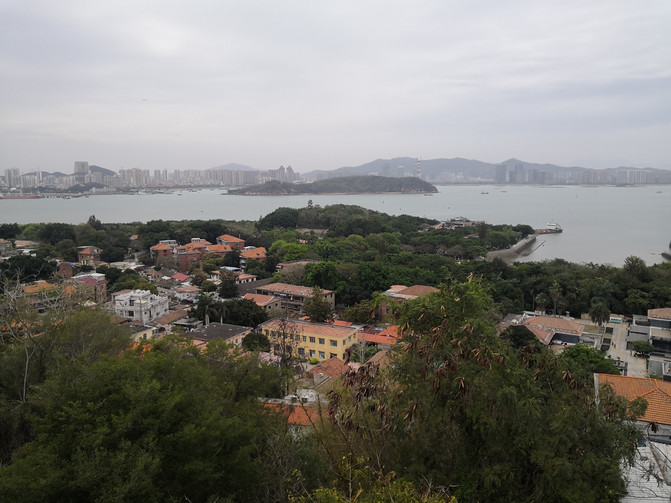
I also passed the particularly dilapidated Qihuang Villa. Without opening the door, I looked in through the crack of the door and saw that they were all very dilapidated houses. There are many beautiful bungalows and villas along the way. It's strange where these houses now belong. Some seem to be inhabited, and some seem to be uninhabited either. The people who live in the hotel must be very proud, but when they see some clothes hanging out on the balcony, they feel very down-to-earth.



Follow the undulating path and walk straight towards Riguang Rock. Passing by a very distinctive building-Trinity Church, I can see that it was built in the 1930s and 1930s, but it looks quite new.

As we approached the entrance of Riguangyan, we saw Gulangyu People's Primary School and Riguang Kindergarten. This kindergarten has a history of more than 100 years. Its predecessor was a family kindergarten founded by British Presbyterian woman Wei Aili in the 24th year of Guangxu of the Qing Dynasty (1898). In the second year of Xuantong of the Qing Dynasty (1910), it was taken over by the British Presbyterian Church. Huaide Kindergarten was named in the third year of Xuantong of the Qing Dynasty (1911). The case was filed in 22 years of the Republic of China (1933). Xiamen was taken over by Japan when it fell in 1930 and renamed Gulangyu Kindergarten. In 1935, the British Presbyterian Church reopened the park and restored the original name of Xiamen's private Huaide Kindergarten. In 1951, the People's Government took over. In 1957, it was renamed Gulangyu Riguang Kindergarten in Xiamen City. In the early days of the "Cultural Revolution", it was renamed the "Anti-Imperialist Kindergarten" and was soon closed. It was reopened in 1974 and changed to a kindergarten attached to Gulangyu People's Primary School. In 1976, it was established independently and renamed Gulangyu Riguang Kindergarten in Xiamen City. Regardless of its history, I hope that the children attending such a beautiful "children's playground" will not be tortured by heavy homework and extracurricular classes, but will only be happy.



Then a large number of tourists entered Riguang Rock. It is indeed magical to have such a huge mountain peak towering into the clouds on this exquisite and handsome island of Gulangyu, so it is a well-deserved landmark attraction on Gulangyu. As the crowd climbed up the spiral steps, there was a coffee shop on the resting platform halfway up the mountain. Many glass words on "Riguang Rock and Gulangyu Island in the Eyes of literati" attracted me. It was quite interesting to see, so I took a photo.

As we approach the summit, we look high from the platform to see the exquisite and beautiful Gulangyu Island and the modern Xiamen represented by the Twin Towers in the distance, and the blue sea and silver beaches set off. It is really picturesque.


I finally reached the summit. Although the scenery is beautiful, there are too many people. The small summit platform is crowded with people and I don't dare to stay. Take a look and hurry down.

After coming out of the Riguangyan Scenic Area, I read the road sign at the intersection and went to the nearby Qinyuan. Listening to the name, I felt that it would be related to music. But after entering, he was very disappointed. There used to be a house where Yin Chengzong's art exhibition was held, but now it is closed and closed.
After that, I went to Shuzhuang Garden. This garden is built along the sea. The garden is on the sea and the sea is in the garden. It has both the exquisite elegance of the Jiangnan courtyard and the majestic majesty of seagulls flying and the waves lapping on the shore. The dynamic and dynamic contrast complement each other. The 44th Bridge built by the sea reminds me of the 24th Bridge on Slender West Lake in Yangzhou. From this bridge, you can see the particularly beautiful huge rocks by the sea, withstood the never-ending beating of the waves.
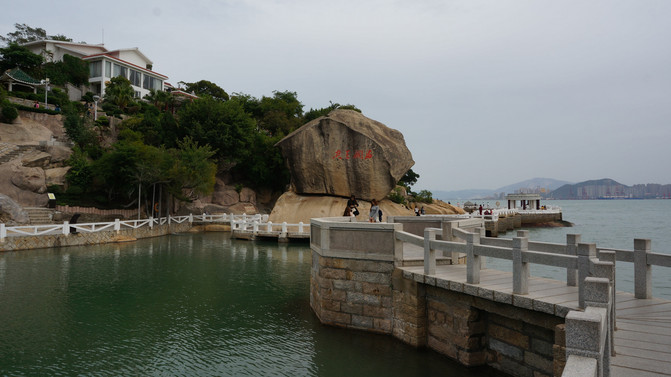





This garden turned out to be Lin's private garden and was later donated to the country. There is an attraction in the park called "Wanshi Mountain House", which looks quite imposing and characteristic, but the mountain seems to be piled up with slag. Because the accumulation is too dense, it feels a little crunchy.

Looking at the Riguang Rock from here, it is even more majestic.

However, in my opinion, the biggest attraction in this garden is not the garden, but the Piano Museum. Unfortunately, only jar No. 2 was opened, and Hall No. 1 was not open. The museum displays a variety of pianos from different eras and different countries. Facing these exquisite and age-old pianos, I think of the Roman Rowland novel "John Christopher" that I was reading recently, and imagined that each piano may be connected to one or more Christopher's stories... The musician who plays the piano may be wearing a tuxedo, feeling proud and handsome; or maybe he is experiencing poverty and is sitting in front of the piano while composing music while feeling hungry...
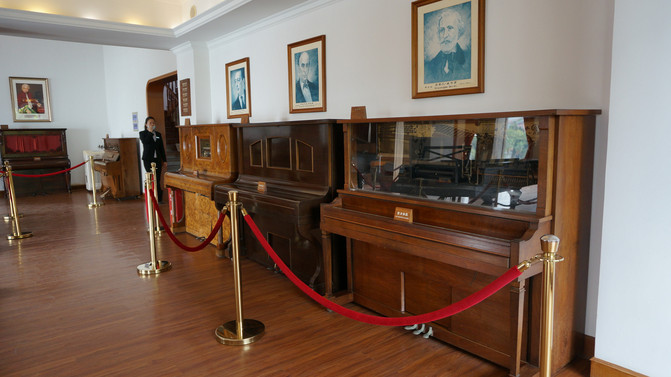


When you come out of this garden, go to the nearby Yuyuan. This is a small park built in memory of the great obstetrician Lin Qiaozhi. It houses the Lin Qiaozhi Memorial Hall and a full-body statue of Lin Qiaozhi.


Then there is left for today's visit, the bright moon, which is also included in the Gulangyu travel pass. This garden is also built along the sea and can basically be regarded as Zheng Chenggong Memorial Park. The most eye-catching thing in the park is the giant statue of Zheng Chenggong, as well as the bronze embossed of Zheng Chenggong.


I'm really tired from walking. I happened to be on the beach in the garden, so I went to the beach to take off my shoes and test the seawater. The seawater was still a little cold, so I decided to sit on the beach and rest.
After visiting Haoyue Garden, I wanted to find crabs to eat. I passed by many beautiful buildings on the way. It is really a shocking museum of international architecture! There are Christ Church, Xu Jiayuan, Lin Mansion, Sea Paradise Building, China Recording Museum, the former site of the Spanish Consulate and its supporting churches, as well as Concord Cathedral, the former site of the Japanese Consulate, etc. Each building has its own characteristics. Among them, Sea Paradise Building has also been jokingly called the "style of wearing a suit and a bamboo hat", which is a combination of Chinese and Western countries, but it seems to me a bit odd. I couldn't really appreciate it (the next day I saw the architectural model of the "Sea Paradise Structure" at the "Gulangyu History and Culture Museum" near the hotel).


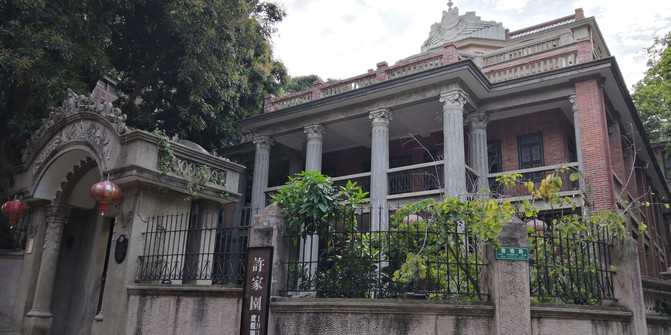






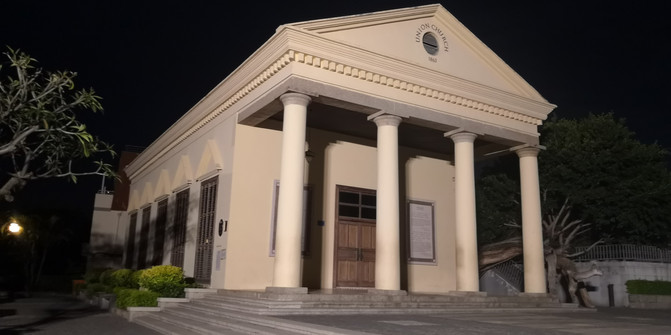
My stomach roared, and I finally found the "Shangyu Aquatic Products" that I was longing for. I ordered a large crab, a plate of green vegetables and a bowl of rice, and had a delicious meal.

When I was looking for "Shangyu Aquatic Products" before dinner, I heard that there was a concert hall nearby, so after eating and drinking enough, I wanted to see the concert hall. After all, Gulangyu is known as the island of music. However, as soon as I walked out, I was a little disappointed to see the dark concert hall. I suddenly saw a figure. It seemed to be a man who had just gotten off work in the office. He came forward to inquire about the situation in the concert hall. It turned out that he was an employee of the concert hall. Seeing my enthusiasm and sincerity for the concert hall and Gulangyu, I took the initiative to take me to visit their concert hall. When he arrived in the concert hall, he turned on the stage lights and asked me to go to the audience to have a look. Facing the lit stage alone, it felt great!

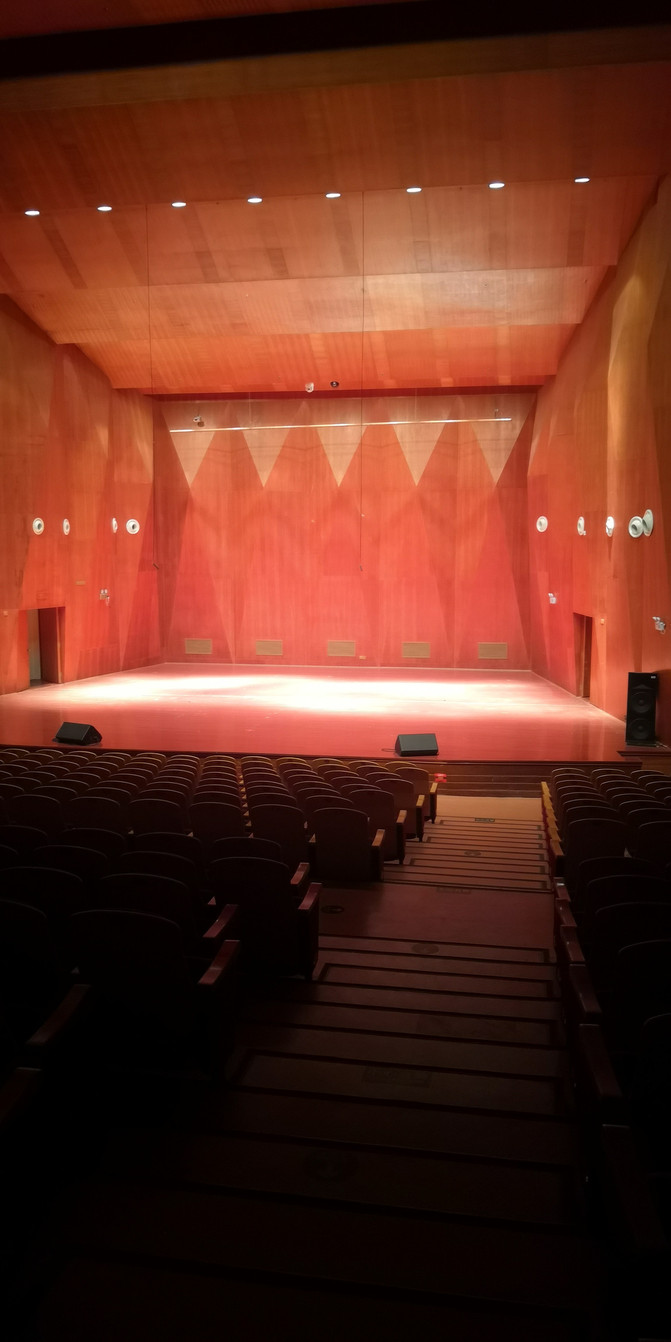
After thanking him, he strolled to Ma John Stadium and Xiamen Coin Cultural Center.





Night has fallen, and a person is walking alone in a strange city and strange streets. There are strangers coming and going, but he does not feel lonely in his heart. Sometimes I think that if I compare humans with cats and dogs, I must belong to the cat. I can be like a cat, having fun playing and playing when I have company, and enjoy myself and enjoying loneliness when I am alone.
The content I've seen in a day is really rich. I'm tired and it's time to rest.
Came out early on the 20th. I first visited the Gulangyu Historical and Cultural Exhibition Hall at my doorstep. I also saw the architectural model of the "Sea Paradise Structure" I saw yesterday. It is indeed a combination of Chinese and Western.

After visiting, I came out and asked the staff where the former British Consulate was. The staff told me that this exhibition hall was the former British Consulate. Upon further inquiry, the former site of the German Consulate was also nearby. It had been transformed into Tong Xiaoman Bakery, and several alpacas were raised in the bakery. It is said that a German consul in the former German consulate took a Chinese wife named Tong Xiaoman.



Later, we found the former site of Japan's Boo Kai Hospital. Then I wanted to find the former site of the Japanese consulate, and navigated all the way to the former site of the Spanish consulate that I visited yesterday. I inquired with the tour guide and found that the red brick house next to it was the former site of the Japanese Consulate. When I walked by here last night, I couldn't see clearly because it was dark. After that, I entered the former site of the Spanish Consulate, which is now transformed into an exhibition hall of ancient costumes of the She nationality, and visited it. I also took some photos of the Catholic Church and Concord Cathedral next to me.




I had long known that the pianist Yin Chengzong was from Gulangyu, so I sensitively saw Yin Chengzong's house on the map, so I wanted to visit it. After all, we were the generation who grew up listening to the piano accompaniment of The Red Lantern. Following the navigation, I saw many other beautiful villas. It was really like visiting the International Museum of Architecture. It was really beautiful. Seeing the bedding in the sun on the balcony of the villa and the aunt drying the bedding, I felt that these houses were warm and popular.


I suddenly noticed that the Ningyuan Building in front of me was actually the former residence of Mr. Lu Jiaxi, the former president of the Chinese Academy of Sciences and a chemist. I was so surprised! I have to sigh that the small Gulangyu Island is really a good place with outstanding people and talents. No wonder the Eight-Power Allied Forces all focused on this precious land and came to extend their feet.

After walking for a long time, I finally found Yin Chengzong's residence at No. 16 Jishan Road. The door was closed. At first, I didn't find the courtyard even when I walked here. The navigation pointed to the back door. The old back door was open, but it was overgrown with weeds and dilapidated. It was impossible to enter. I walked around the front door and found it. This is No. 16 Jishan Road. There are many beautiful flowers planted in the front yard, and the house is also beautiful and seems to be inhabited. Later, at the intersection, he saw an old man explaining Yin Chengzong's family history and Yin Chengzong's experiences to several tourism-like people. Only then did he learn that the house had actually belonged to his brother for a long time, and Yin Chengzong had never lived here at all. From the old gentleman's introduction, I learned that Yin Chengzong can be said to be "a red flag for success, and a red flag for failure." But only playing the piano well is his true strength and even vitality.



Then follow the navigation to find Pinyin Road. This is a stone path leading from top to bottom to the seaside beach built in memory of Mr. Zhuang Zhang, who contributed to the promotion of Mandarin in southern Fujian. Each step is engraved with some pinyin, so it is called Pinyin Road. Walking down to the beach, I saw a bust of Mr. Lu.
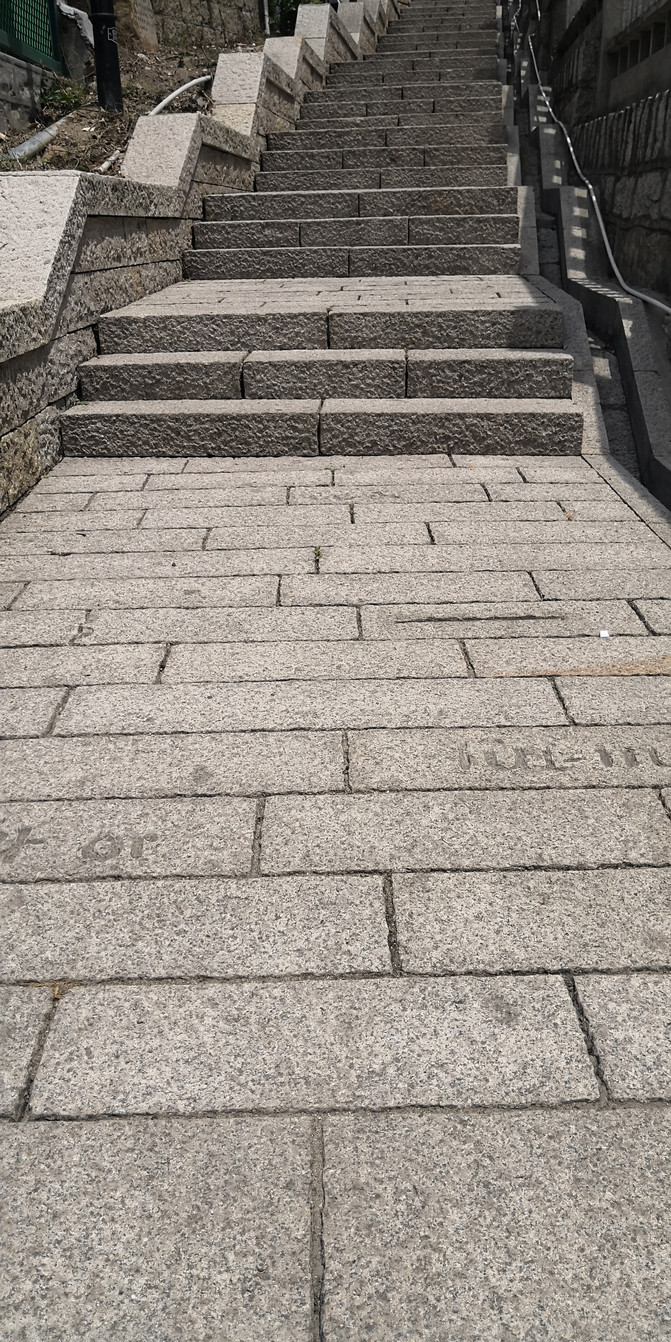

Walking along the beach, you will soon reach Drum Drum Cave. Some photos were taken in front of, behind, inside and outside the cave. After passing through the tunnel, I saw many people treading on the beach, so I really wanted to have a good time. Take off your shoes and socks and start riding the waves. In order to leave a little memory for myself, I took some photos and videos with a tripod. When I get old and can't walk or leave the house, it will be quite interesting to slowly watch these exciting little videos at home.
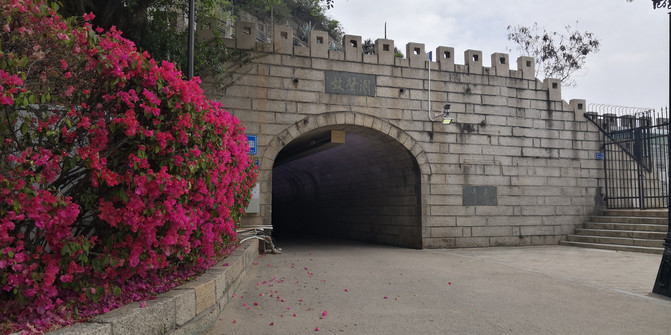


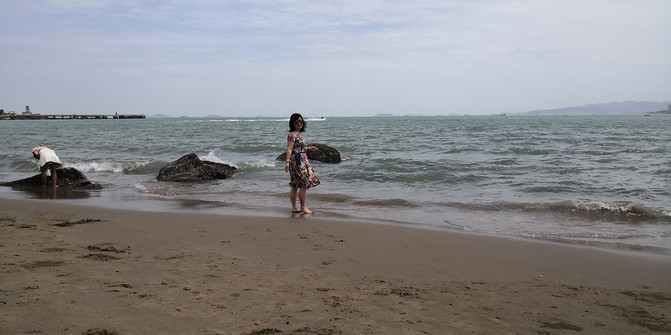
After the sea broke out, the Hu Krupp put on shoes with the sand on his feet. Thinking of hearing about the Sun Yat-sen Library on the island in the concert hall yesterday, I thought to myself, it would be nice to go to the library for a while on this hot day. From the map, it was right next to the Majohan Sports Field, and it was quickly found. But unexpectedly, when I entered the library to scan the code, I met the employee who showed me the concert hall yesterday. I was surprised to meet him by accident. It turned out that the library and the concert hall belonged to the same large unit, and his work ran from head to toe. I flipped through magazines and books on the first and second floors of the library, read a "preface" to a biography of Master Hong Yi Li Shutong, and had a little understanding of Master Hong Yi, which made it possible for visiting Master Hong Yi's Memorial Hall elsewhere in the future. Sitting in the quiet and cool library reading a few pages and taking a break at this time feels extremely wonderful.


Then I looked at some buildings on the way back to the hotel. I passed by a post office and went in to buy a souvenir. As always, I still bought a refrigerator and posted a bar. I found that many of the patterns on the refrigerator here were the red dome of Gulangyu's landmark building. I suddenly remembered that this was probably the Bagua Tower I had seen many times on road signs, but I hadn't been there in the past two days. You have to go! It happened to be in the same direction as Sanqiutian Wharf, so I went back to the hotel to pick up my luggage, dragged my box, followed the navigation and walked towards Bagua Tower. Only when I arrived at the Bagua Tower did I realize that this was the real organ museum. Yesterday, I only went to an organ art center (I didn't do my homework well enough and almost made a mistake). Not the same thing! In order to see this Bagua Tower, I pulled a big box and climbed a big uphill slope and climbed many steps. I was exhausted, but it was still worth it. In fact, when you get to the Bagua Building, you can't see the red dome. Let's go into the museum and see the organ. It's really great. In my impression, the organ is the kind of wooden box that the teacher taught us to sing in primary school music classes. It's just a little wider and thinner than a small desk and it's just two pedals and a keyboard. I have never seen or imagined it to be such a luxurious, exquisite, diverse, complex structure, and even spectacular organ. It is no wonder that this museum is said to be the only organ museum in the country and the largest in the world.






Looking at the introduction, I learned that the owner of all the collections of the Gulangyu Piano Museum and the Organ Museum is this Australia Chinese Mr. Hu Youyi who was born in Gulangyu. He is also the director of the museum. According to reports, Mr. Hu Youyi's plan is to increase the collection of Gulangyu Organ Museum to more than 400 units within five years (I don't know when it starts). Mr. Hu Youyi also hopes that people can not only see a variety of ancient piano treasures here, but also see the shape and internal structure of the pipe organ, but also regularly enjoy the solemn and holy performance of the pipe organ. This has become one of the reasons why I want to come to Gulangyu again.

Well, this two-day tour of Gulangyu ended successfully with the Organ Museum. After that, we went downhill and rushed to Sanqiutian Wharf not far away and back to Xiamen. Looking back on the boat, we look at Bagua Tower and Gulangyu, and reminisce about what we have seen and heard over the past two days. It takes more than ten minutes or more than twenty minutes to reach the Xiamen Cruise Terminal.


I took a taxi back to the Motel hotel where I stayed before. Lay in bed and call home. Then go to a nearby supermarket to buy some food and drink.
When you come from the north to the south on the 21st, you always have to visit the Botanical Garden. Xiamen Botanical Garden is also called Wanshi Botanical Garden. The plants here really have southern characteristics and are very different from the plants in the north. This botanical garden is built on a hillside and has a large area. After entering the garden, it is really difficult to visit it all the way uphill. After entering from the west gate of the park, the first thing you see is the Wanshi Hancui Scenic Area, which is the largest water feature in the botanical garden. Unfortunately, probably because the weather is too dry, the lake water is almost dry.


Then follow the instructions on the tour map and start from the right line first. Before walking far, I saw a group of people taking photos around a big tree. It turned out that the stone tablet under the tree said that it was the tree planting place of Old Man Deng Xiaoping's house and that it was a big camphor tree. The nearby area is the Araucaria lawn. Not far away, I saw another big tree with a stone tablet. It was planted by Wang Zhen's family. It obviously didn't attract many people to take photos here.



Continue to walk to the right from the Araucaria Lawn and you will soon reach the Hundred Flowers (Hua) Hall. There are some water lilies that have already bloomed here, and in the north, only "small lotus flowers show their sharp horns". There are also some flowers and plants such as bougainvillea, which are very brilliant.


Get out of this garden and enter the palm plant area. This is a rare scenery to see in the north, and I am a little happy. So I found a secluded place to set up a tripod and took more photos.




Then turn left and enter the bamboo area. However, I was very disappointed. Probably because the weather was too dry, many bamboos were dry and yellow.

After that, he could not move forward due to road construction, so he had to retreat to Baihua Hall. In fact, almost half of the garden on the left is under construction, so it is impossible to stroll around.
Returning to the right route, I continued to the Qiqu Botanical Garden. The Qiqu plants seemed to be indoors and were not open now, so I didn't see any very interesting plants.


Keep walking and you will find the rainforest world. Think about the tropical rainforest you have visited in Banna, Yunnan. It is a moist virgin forest that blocks the sky and the sun. You need to walk up the mountains. I have little interest in it. I want to save my legs and feet, so I only walked a little. I came out and headed straight to the meat-rich area. There is no disappointment here! In this small park, huge cacti and other succulent plants are diverse. The noon sun shines directly on this small artificial desert, making it feel like being in Mexico or some other tropical desert country for a while.





I was really tired from wandering now, and I wanted to go to the ginger plant area, so I took a scenic sightseeing bus. We first arrived at the National Defense Park, got off the car, and walked for a short way to Jiangmu District. It turns out that ginger plants are just banana trees, banana trees and the like. I really didn't know what ginger plants were before, so I learned more. Probably because it is not easy to walk all the way up from the entrance to here, there are very few tourists in this garden. Good, then take more photos in this very southern garden!


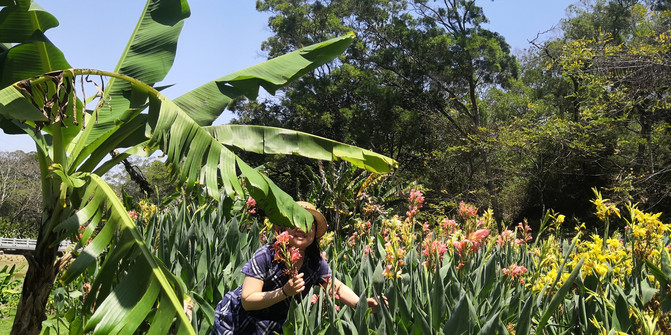

Go back to the gate of the National Defense Park and get on the sightseeing bus. I originally thought that there was a path in the succulent area that could lead to the other side of the park, but maybe because of the road construction, I couldn't find a way to cross, so I turned around in the succulent area again and found something I hadn't seen before. It's quite satisfying.
The flowers and flowers on the roadside are also very bright, and there are also some small romantic things:




I took another sightseeing bus and went straight to the West Gate, but I was not willing to go out directly, so I walked around Wanshi Hancui on the left road. I wanted to find gymnosperms but couldn't find it. After walking around Songshan Garden, I finally returned to the West Gate after a large circle around Wanshi Hancui Lake. I was very tired and left the Botanical Garden.
After leaving the Botanical Garden, I quickly found a bicycle. I originally wanted to follow the railway tracks at the west gate of the Botanical Garden to find the Railway Cultural Park. As a result, when we reached the park gate, we couldn't find an area to park bicycles (the management of shared bicycles is stricter than in Beijing). When I leave this park in anger, I'd better ride my bike to Shapowei Art West District. But later I found that there were too many uphill roads to ride. So I found a place to park my bicycle and took a ride to Shapowei. Shapowei Art West District was transformed from the original Xiamen Aquatic Products Processing Factory using old factory buildings such as a refrigeration plant, equipment room, shellfish purification center, and factory warehouse. It is a young cultural and artistic district that has emerged on the edge of Xiamen Shapowei Shelter. According to the introduction, some art studio activities, as well as some large-scale themed art/trend activities, are regularly held here. However, when there are no special events here, it does not look very artistic or literary. The feeling of visiting can only be said to be a relatively petty place, quite commercial, and not as avant-garde artistic as Beijing's 798. There is no artistic atmosphere like Songzhuang in Beijing. The graffiti in the corridor is quite lively.


At a glance, in the Art West District, most of them are girls and young men in their 20s and 30s, young people or petty capitalists. It seems that there are a bit scarce for "literary and artistic youth" at my age and experience. Who cares, since you are here, I will do as the Romans do. I am tired and thirsty. Have a cup of light cheese and strawberry snow mountain that is delicious and delicious. It will be cold and cool, and I will feel young (I haven't had a cold drink like this in a long time).


When I came out, I saw a roadside stall selling a local glutinous rice cake. I wanted to eat when I was in Gulangyu, but there were too many people in the queue and I couldn't get it. I bought one with me today and eat it when I am hungry. Then I remembered that I saw the Cat Street passing by in the taxi just now, which seemed not far away. I checked the map and rode my bicycle there. But it doesn't mean much. It's just a small street with several ceramic cats on the street, some cat portraits are decorated on the walls, and several gift shops are almost full of all kinds of cat toys. If you like cats very much, you may have a big harvest.




It's approaching evening, and I have to rush to Bay Park to watch the sunset when the sun sets. So I checked the nearby bus stop and took a few stops to Bay Park. At this time, many people were already sitting on the stone steps by the sea, waiting to watch the sunset. I also found a place to sit down and quietly waited for the sun to come home while enjoying the glutinous rice cake I had just packed.
The setting sun set the sea red, and at this time, I especially hope to share the beautiful scenery in front of me with my family, so
I dialed a video for my mother and watched the sunset in the bay with my relatives:





After watching the sunset, I went to Zhongshan Road and wanted to buy some local specialties. I found that many shops on Zhongshan Road were closed and couldn't walk through it. So I found a restaurant nearby, packed a portion of the ginger duck recommended by the boss, and then took it back to the hotel to enjoy my ginger duck.
22nd. Today is the last day in Xiamen. When I woke up in the morning, I thought Metro Line 2 was also a cross-sea line. I wanted to see the cross-sea subway section again, so I took the subway to Haicang Bay Park on the other side of the sea. But what is disappointing is that Metro Line 2 takes an undersea tunnel instead of a cross-sea bridge from the cruise station to Haicang Bay Park. When I saw nothing, I left the subway and just played in the park. It was a very ordinary seaside park.


Then, I originally wanted to go to Zengcuo 'an after entering the subway, but I was not very willing to do so. So I took the subway again and changed to Line 1, went to Jimei Xuecun, and took the sea subway line back and forth twice. Then I went to Zengcuo 'an. As soon as I arrived at Zengcuo 'an, I saw a roadside stall selling "coconut laying eggs". The owner carved a fresh coconut in a circle with a knife, lifted the lid on it, and put it into the bowl. The white, tender and soft pouch came out, and I was stunned. So I asked the master to help me "lay an egg" for 25 yuan, carry the egg across the bridge, and eat while walking (it doesn't seem like anything indecent here, but it seems very leisurely) to go to Zengcuo 'an Market. I found Yuhai Local Specialty Chain Store, a big store selling local products I saw last night, selected a large number of specialties and sent express delivery to my family members in various places. After finishing this pile, I finally caught my breath and came out to find a restaurant that grilled raw oysters. It cost ten yuan. It was beautiful and enjoyable to eat.

Unconsciously, I have been in Xiamen for seven days. With beautiful memories (which will also become beautiful memories in the future), I bid farewell to Xiamen. I still have a new journey to continue.
(To be continued)
Previous Article:[Xiamen Strategy] Go to a six-year appointment and write a song of years passed by-Xiamen Strategy
Next Article:Open a new Xiamen vacation posture on Xianyue Mountain and experience the different beautiful scenery of Xiamen
